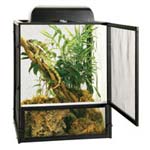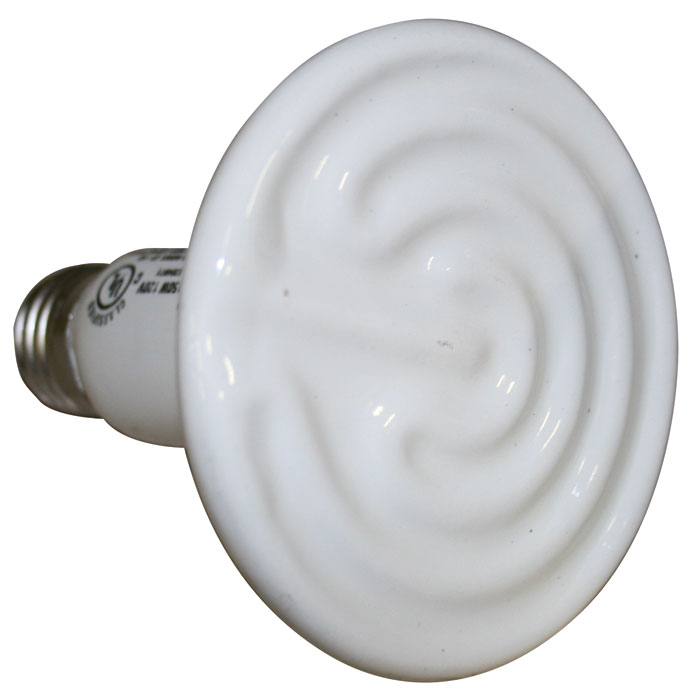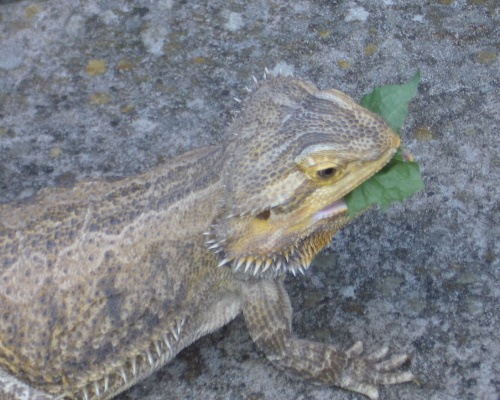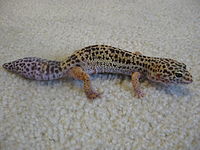Both Bearded Dragons and Leopard Geckos are about as close to “perfect” as a reptile pet can be, and either is a great choice for new and experienced owners alike. But the costs of ownership, both short and long term, do vary between the two. Novice reptile enthusiasts sometimes obtain their first specimens without fully investigating this point, and may be surprised (or delighted!) at the expenses involved in their care – especially as each can reach 20 or even 30+ plus years of age! In the following article I’ll compare the start-up and long-term costs of owning Bearded Dragons and Leopard Geckos.
There are also major differences in the habits, activity levels and care needs of Bearded Dragons and Leopard Geckos. Please see the articles linked under “Further Reading” for a comparison of their habits and husbandry, and for detailed care information. As always, I welcome any questions or observations that you may wish to post.
Start-Up Expenses
Purchase Price
The cost per animal is similar for individuals that exhibit natural coloration. A huge array of uniquely-colored “designer morphs” of each species has also been developed. Prices for such animals vary greatly, but are in similar ranges for both geckos and dragons.
Verdict: Similar for natural coloration – varies based on color morphs
Terrarium and Cover (single adult)
Bearded Dragon: 30-55 gallon aquarium and cover
Leopard Gecko: 10-20 gallon aquarium and cover (larger is preferable)
Verdict: Bearded Dragons require larger, more expensive habitats
UVB Fixture and Bulb
Bearded Dragon: Full length florescent UVB fixture and bulb
Leopard Gecko: UVB exposure not required
or
Mercury vapor fixture and bulb
Verdict: With their UVB requirements, Bearded Dragons cost more.
Bearded Dragon: Incandescent fixture and bulb for basking site
Red/black bulb or ceramic heat emitter (night)
Leopard Gecko: Incandescent fixture and bulb for basking site
Heat tape or ceramic heat emitter (night)
Verdict: Bearded Dragons require higher temperatures, but the cost is negligible for the equipment.
Other Supplies
Both will also need a substrate or terrarium liner, caves, and driftwood or rocks upon which to bask. The costs for these items are similar for each species.
Verdict: Other supplies are similarly priced across species
Food
Bearded Dragon (adult): 36-48 insects per week
Leopard Gecko (adult): 15-25 insects per week
and
3 bowls salad per week
Please note that these figures are meant to provide a general idea of expected food intake. The actual amount of food your lizard will consume is influenced by temperature, the type of insect offered (i.e. 1 cricket vs 4 sowbugs vs 2 butterworms, etc.), general health, age, and the animal’s individual metabolism. Please see the linked articles and post any questions about your pet’s specific needs below.
Verdict: Bearded Dragon adults consume almost twice as many insects as leopard geckos – and also require salads. Juvenile requirements can be even greater. Bearded Dragons cost considerably more to feed.
Ongoing Expenses Unique to Bearded Dragons
Bearded Dragons grow significantly larger than do Leopard Geckos, and will need roomier terrariums (please see above) as they mature
UVB bulb and fixture replacement will also be necessary (Leopard Geckos do not require UVB exposure).
Ongoing Expenses Common to Both Species
Although both lizards are quite hardy if properly cared-for, occasional veterinary visits can be expected. The costs for such are comparable to those charged for cat or dog care. Intestinal impactions (from swallowing substrate) and diseases related to poor nutrition may be encountered by geckos and dragons alike.
If a moist shelter is not available, Leopard Geckos may suffer retained eyelid linings when shedding, while Bearded Dragons that are denied proper UVB exposure will develop metabolic bone disease and related afflictions.
Atadenovirus infections, which are increasing in captive Bearded Dragon populations, are as yet incurable.
Verdict – Veterinary expenses are basically the same for both species
Other Expenses
Substrate replacement and vitamin/mineral supplement costs remain similar for both species over time. Electrical expenses will also be in the same range, although Bearded Dragons require higher temperatures than do Leopard Geckos (75-110 F as opposed to 72-90 F).
In Conclusion
Overall, a Bearded Dragon is the more expensive pet to maintain, due to this species’ needs for spacious living quarters, access to UVB radiation, and large, frequent meals. However, veterinary care needs cannot be predicted – as few visits by a relatively “inexpensive” gecko can level the field!
 That Reptile Blog – Reptile, Amphibian and Exotic Pet Care and Information
That Reptile Blog – Reptile, Amphibian and Exotic Pet Care and Information







This was the decision I faced two years ago… I really wanted to get a bearded dragon, but the space requirements and additional heating apparatus ultimately led me to choose a leopard gecko. I now have two and really love them.
Either way I don’t think you could go wrong choosing between these two lizards 🙂
Am a bit surprised about the leopard gecko heating requirements you listed. Almost everything I’ve read suggests under tank heaters and cautions that heating bulbs can actually cause a lot of stress.
Hi Paul,
Thanks for the feedback, much appreciated.
Regular bulbs (incandescent) are fine for daytime use; red/black work well at night. there’s been much internet speculation about these (nite bulbs) but we’ve used them in zoos for decades with a huge array of animal, from inverts to mammals, with fine results. Heat pads good also, just be aware that they may not do much to heat the air (depending on substrate depth, etc).
Enjoy, Frank
You’re overfeeding your Leo’s with that estimate and heat should be provided by an UBH pad, not overhead heat. This is even cheaper, last much longer.
Hello,
Thanks you for your thoughts.
Please see article’s note re variability of food intake.
Heat pads have benefits and limitations, as mentioned; I’ve used bulbs throughout my zoo career for this and similar species with excellent results.
Please feel free to write in with details if you have specific questions, best, Frank
hi, my leopard geckos tail feel off, she hasn’t been eating. Any advice?
Hello,
Tail shedding is common if the animal is grabbed by the tail, fighting with another etc. If it comes off for no apparent reason, and the animal ceases feeding, vet advice should be sought. Please feel free to send along details about heat, tank set-up, diet etc. so I can have a more complete picture of the situation. best, Frank
Thanks Frank. and I use a heat lamp (black at night) and it generally stays around 70 degrees, she hasn’t been eating. I have crickets and mealworms in there and she hasn’t touched them. earlier in the day I was watching her and she took a really runny clear poop and then had like a red slit on her butt that she was licking. is that normal?
Hello,
I can’t tell if the tail and other conditions are related to the low temperature, but your first step should be to establish a temperature range of 77 F at the cooler side to 88 F at the warmer side of the terrarium. At 70F, the animal will not feed.
Please also note that mealworms should be avoided, and crickets alone are not an appropriate diet. Please see the articles below for more on care and diet, and let me know if you need any other info, best, Frank
http://blogs.thatpetplace.com/thatreptileblog/2013/06/07/leopard-gecko-care-the-ideal-gecko-terrarium-a-zookeepers-thoughts/#.VEB61clDV30
http://blogs.thatpetplace.com/thatreptileblog/2014/02/26/leopard-geckos-eat-heres-zoos/#.VEB7M8lDV30
Hello,
I have a crested gecko and I will set up a bearded dragon soon. Actually I have her, but she is in hibernation. What are the behaivioral differences I will notice other than that the one is diurnal and the other nocturnal? And what of all these said is true about bearded dragons?
Are they for example truely active animals? I haven’t seen dragons for much time, but every time I saw them they were either positioned under the lamp to bask, or lower on the branch to cool themselves. Only one time I happened to see a pair in a cage, and again they were chilling most of the time next to each other in the basking spot. They had some bouts of activity, but only for a few seconds at a time. On the other hand my crested gecko is quite active. He doesn’t rearrange the cage all night, but he has a reasonable activity pattern for its metabolism. Dragons are described as ambush foragers like all agamids, so this might be the reason. The fun thing is that they like food too uch and you can feed them whenever you want and watch. A gecko will eat nothing if its stomach is full.
How much intelligent they truely are? All people say geckos are much less intelligent, but how intelligent is an animal that allows itself to be picked up by anyone, is duped by laser pointers and moving dots on a screen, tries to eat paper like leaves, cannot understand glass sometimes, and even in nature is caught easily? They are pathologically calm. Do their human recognition abilities are just from their perhapse higher visual acuity only? In nature, they interact with themselves, and usually for dominance reasons. So I don’t believe that they have a special affinity for humans. Most probably the complete opposite is true, namely they seem to like umans because they cannot understand what we are. What signs wil convince me that they are more intelligent?
ps. Leopard gecko breeders have based their animals’ diet on mealworms without problems. They are desert animals, much tougher than people think. They can eat hard things, they can go for time without food, and they are true hibernators.
Hello,
Bearded dragons spend most of their time basking, unless especially hungry or in breeding mode.
There really aren’t any realistic ways to compare or rate intelligence (other than in some cases by controlled experiments) especially when we are trying to draw conclusions based on captive observations. each species has evolved to survive in a particular environment, and it’s instincts and learning abilities are fine-tuned to that end. It is also difficult to access, n most cases, what if anything reptiles are learning, as we cannot always see or comprehend their reactions (internal survival-based hormonal reactions, etc.).
Some of the leopard gecko info claiming success with mealworm based diets are misleading…they should live into their 20’s and 30’s…animals aged 10 or so are not at all exceptional,; some nutritional difficulties take years to manifest themselves. Diets should not be based on mealworms; newly molted individuals are fine on occasion. best, Frank
Of course an insectivore needs a variety of prey, just I am repeting what other breeders say. But where exactly is the evil with the mealworm? Is it because it is nutritionally deficient or because it is hard? Because nutritionally, from many source I have read, it is normal, with some excess of fat. Many healthy reptiles eat them without problem, of what I know. Even my crested gecko eats them and defecates fine.
I strongly suspect that the demonization of the mealworm has to do with commercial interests of breeders raising other insects. That is the reason you don’t find nutritional information on rarer feeders or toxicity information on common wild insects, like tomato hornworms.
Hello,
Actually there is quite a bit of published info concerning nutritional values of many feeders, but much of it is in professional journals available by subscription only,. The mealworm had been a zoo staple for nearly 75 years (no longer relied upon however) and has been well studied, as have others.
Useful sources of related info include the journal Zoo Biology, the International Zoo Yearbook, the European Zoo Nutrition Society; books written by vets specializing in this area are also generally excellent – the work of the late Dr Kevin Wright stands out in this regard.
Mealworms present a poor Calcium:Phosphorus ratio (this affects how calcium is utilized, made available to the animal etc), which seems difficult to improve via nutrient loading/supplementation. Also, the chitin content of the exoskeleton is very high, presenting digestive difficulties. Way back when mealworms were regularly used at the Bx Zoo, impactions comprised of exoskeletons were often seen upon autopsy (all animals which expire are autopsied).
Animals consuming similar prey items in the wild may still suffer impactions etc in captivity…digestion, ability to expel wastes etc is affected by CA levels, hydration, the rest of the diet, general health, the diet of the prey item and other factors.
Best, Frank